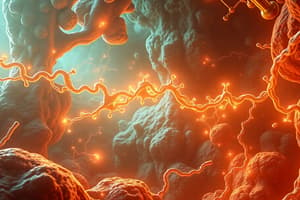Podcast
Questions and Answers
Which tissues primarily require NADPH for the synthesis of fatty acids?
Which tissues primarily require NADPH for the synthesis of fatty acids?
- Skeletal muscles and adrenal cortex
- Liver, mammary glands, and adipose tissue (correct)
- Liver and skeletal muscles
- Adrenal cortex and red blood cells
What is the primary consequence of diminished glucose 6-phosphate dehydrogenase (G6PD) activity in red blood cells?
What is the primary consequence of diminished glucose 6-phosphate dehydrogenase (G6PD) activity in red blood cells?
- Enhanced detoxification of free radicals
- Increased lifespan of red blood cells
- Increased synthesis of nucleotides
- Impaired formation of NADPH (correct)
Which enzyme is involved in the oxidative reactions of the pentose phosphate pathway?
Which enzyme is involved in the oxidative reactions of the pentose phosphate pathway?
- Lactate dehydrogenase
- Glucose 6-phosphate dehydrogenase (correct)
- Transaldolase
- Transketolase
Which of the following statements about G6PD deficiency is true?
Which of the following statements about G6PD deficiency is true?
What is the effect of oxidative stress on individuals with G6PD deficiency?
What is the effect of oxidative stress on individuals with G6PD deficiency?
What is the primary consequence of glucose 6-phosphate dehydrogenase deficiency in erythrocytes?
What is the primary consequence of glucose 6-phosphate dehydrogenase deficiency in erythrocytes?
Which of the following describes the role of glucuronic acid in the body?
Which of the following describes the role of glucuronic acid in the body?
In which organ does the uronic acid pathway primarily occur?
In which organ does the uronic acid pathway primarily occur?
What is the function of UDP-glucuronic acid in metabolic pathways?
What is the function of UDP-glucuronic acid in metabolic pathways?
Which compound is produced in the oxidative pathway utilizing glucose 6-phosphate?
Which compound is produced in the oxidative pathway utilizing glucose 6-phosphate?
Flashcards are hidden until you start studying
Study Notes
NADPH and the Pentose Phosphate Pathway
- NADPH serves as a biochemical reductant, crucial for anabolic processes.
- Ribose 5-phosphate is vital for nucleotide biosynthesis.
- Irreversible oxidative reactions are important in specific tissues:
- Liver, mammary glands, and adipose tissue utilize NADPH for fatty acid synthesis.
- Adrenal cortex synthesizes steroids using NADPH.
- Red blood cells (RBCs) maintain a reduced state of glutathione.
- Skeletal muscles have minimal involvement in this metabolic pathway.
Metabolic Pathways Overview
- The pentose phosphate pathway features two reaction pathways:
- Irreversible oxidative reactions.
- Reversible sugar-phosphate interconversion.
Glucose 6-Phosphate Dehydrogenase (G6PD) Deficiency
- G6PD deficiency is an inherited condition leading to hemolytic anemia due to impaired detoxification of oxidizing agents.
- It is an X-linked disorder with potentially shortened lifespan due to chronic hemolysis complications.
- Low G6PD activity affects NADPH formation, decreasing glutathione pools and reducing oxidative stress detoxification.
- Precipitating factors include:
- Oxidative stress from certain drugs.
- Ingestion of fava beans (Favism).
- Infections.
Uronic Acid Pathway
- An alternative oxidative pathway yielding glucuronic acid, predominantly occurring in the liver.
- Produces UDP-glucuronic acid, which is an active donor for conjugation with steroids, drugs, and bilirubin.
- Supports glycosaminoglycan biosynthesis.
Regulation of Gluconeogenesis
- Substrate availability and low insulin levels favor gluconeogenesis by mobilizing amino acids from muscle protein.
- Glycerol, from lipolysis in adipose tissue, is utilized in this pathway.
- The liver predominantly (90%) carries out gluconeogenesis, with the kidney contributing (10% during fasting).
Citric Acid Cycle (Krebs Cycle)
- Occurs entirely in the mitochondria, producing ATP by oxidizing carbohydrates, amino acids, and fatty acids.
- Two carbon atoms enter as acetyl CoA, exiting as CO2 without net consumption of cycle intermediates.
- A total of 12 ATP is generated per acetyl CoA oxidized:
- 3 NADH → 9 ATP.
- 1 FADH2 → 2 ATP.
- 1 GTP → 1 ATP.
Regulation of the Citric Acid Cycle
- Isocitrate dehydrogenase is activated by low ATP/NAD+ levels for increased reaction rates.
- High ATP/NADH levels inhibit citrate synthase to slow the cycle.
Cori Cycle and Lactate Utilization
- Gluconeogenesis primarily reverses glycolysis while involving unique enzymes for irreversible steps.
- Lactate produced by exercising muscles and RBCs is converted back to glucose in the liver via gluconeogenesis.
- This cycle provides energy for the nervous system, renal cortex, cornea, and lens among others.
Importance of Glucose
- Essential for energy supply to the brain and RBCs, as well as a vital source during muscle exertion and pregnancy.
- Important for lactose synthesis in lactating mammary glands.
Studying That Suits You
Use AI to generate personalized quizzes and flashcards to suit your learning preferences.




